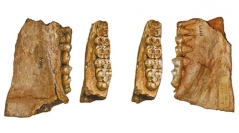

 Geodiversitas
35 (3) - Pages 655-689
Geodiversitas
35 (3) - Pages 655-689Part of the problem of interpreting fossil suids has been the misplacement or loss of material described during the 19th Century, which makes comparisons difficult because usually only occlusal views of teeth were illustrated and the illustrations, although labelled as “natural size” often differ from the real dimensions, sometimes by as much as 10%. Some of the fossils attributed by Blainville (1847) and Gervais (1850, 1859) to Sus provincialis Blainville, 1847 are preserved at the University of Montpellier II (some are mislabelled due to the fact that several of the illustrations are reversed) and one original specimen and a set of casts is preserved at the Muséum national d’Histoire naturelle, Paris. Fossils found after Gervais’ publications reveal that the deposits in the neighbourhood of Montpellier contain four species of suid, Dasychoerus arvernensis (Croizet & Jobert, 1828), Dasychoerus sp. from Kvabebi, “Sus” provincialis Blainville, 1847 and Dasychoerus strozzii (Meneghini, 1862) and that ever since Blainville’s (1847) publication, as well as those of Gervais (1850, 1859) and above all the monograph of Stehlin (1899-1900) the concept of the species “Sus” provincialis has been based on a chimera of two taxa (“Sus” provincialis and Dasychoerus strozzii). In order to ensure stability of nomenclature, it is necessary to avoid nominating a lectotype that might belong either to Dasychoerus arvernensis or to Dasychoerus strozzii. For this to succeed a detailed revision of the Montpellier suids is necessary.
Suidae, Pliocene, Montpellier, lectotype, systematics, biochronology, lectotypification